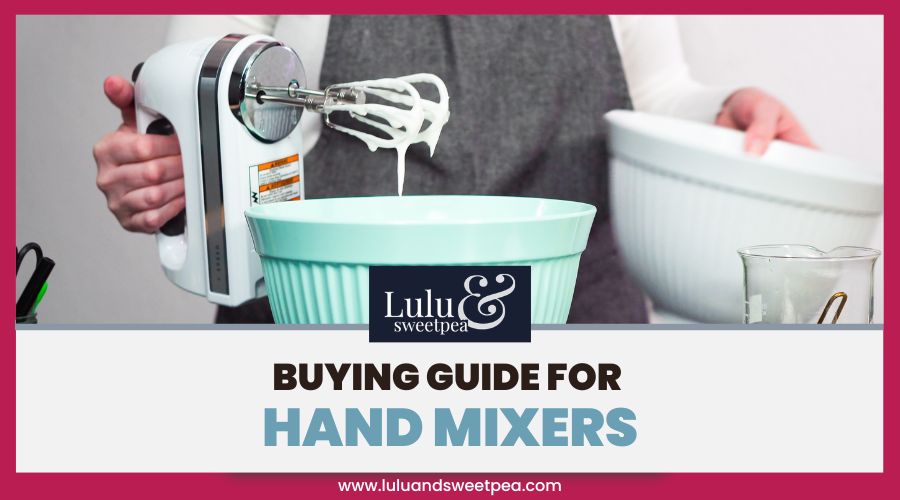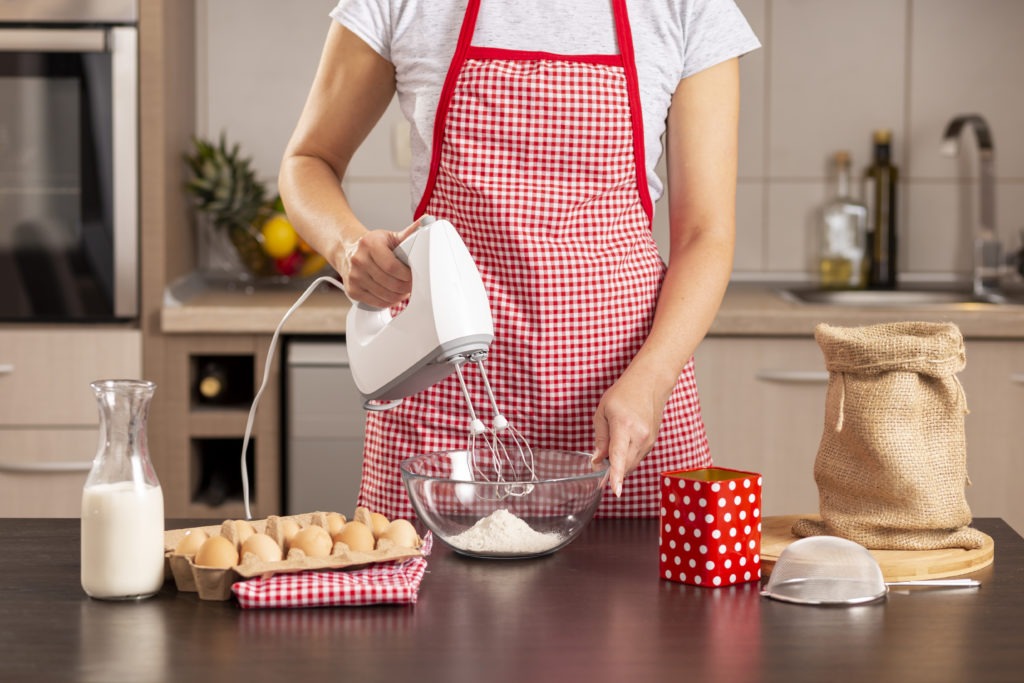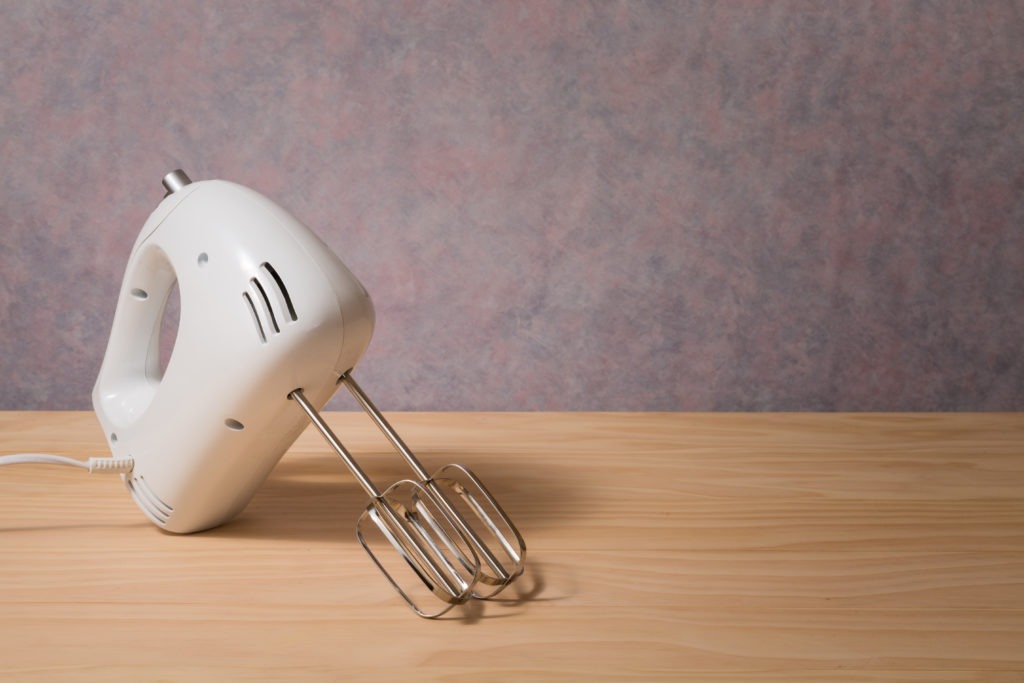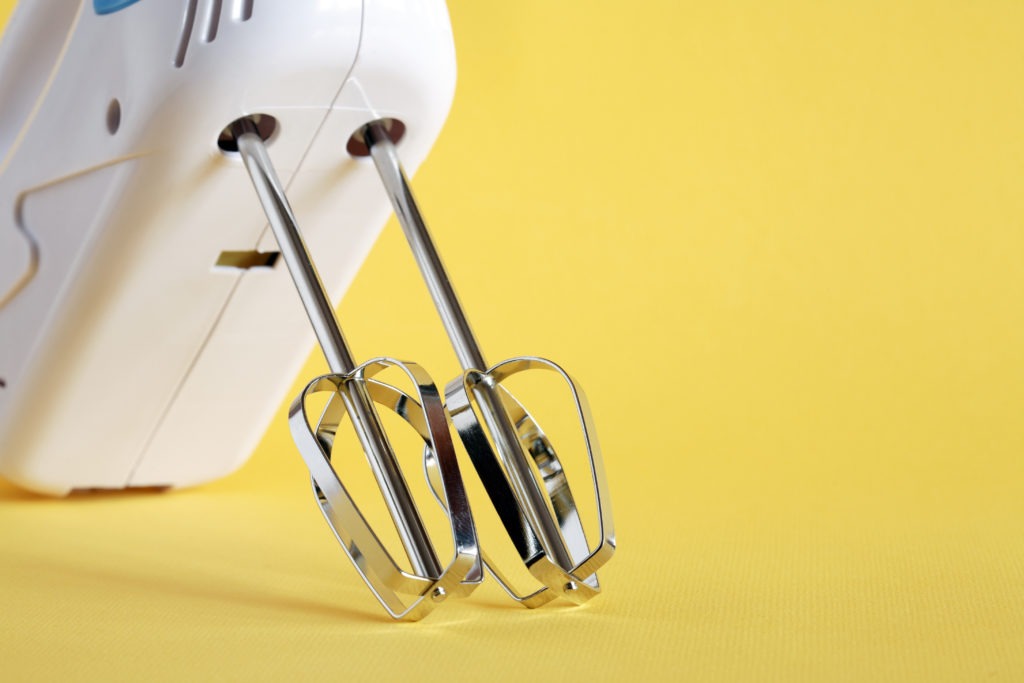Investing in a good hand mixer is a no-brainer for any enthusiastic baker. They are easy to use, versatile, and straightforward. They are more affordable than stand mixers and need less storage space because they are compact. They are perfect to use when you need to whip up fluffy egg whites or mix cream, butter, and sugar together to make baked goods. But choosing a hand mixer can be hard if you don’t know what to look for. This is a guide that will help you decide.
What is a Hand Mixer?
A hand mixer is a small kitchen appliance used to mix and blend ingredients. It’s like a whisk, but it’s electrically powered for convenience and to be able to handle heavier tasks like making whipped cream, icings, or kneading dough.
It’s more compact and affordable than stand mixers, but they need more manpower. Unlike a standing mixer, you can’t leave it on its own. However, they can give you more control when mixing ingredients.
All hand mixers come with detachable beaters for making cakes, whipping cream, and blending batter. Some even have dough hooks for making bread.
Things to Consider When Buying a Hand Mixer
If you need to buy a hand mixer but need help deciding which one, here are the things to consider before purchasing:
Purpose
Hand mixers are not just for whipping cream and mixing cake batter. They can also blend soups, shred chicken, and even mash potatoes. But you need an appliance that can handle the task you have in mind and up to the frequency of the use you might need. Cheap hand mixers can be enough for occasional use, but if you are a busy cook or baker who will use the hand mixer a lot, then investing in a higher-grade model is a better idea.
Design features
When shopping, you might fall for the pretty color or sleek structure, but you have to consider if the design is practical for you. When your hands are always getting tired while using the mixer, you won’t love it for sure. Here are some design attributes to look for in a good hand mixer:
- It must have a rounded shape with buttons that are easy to reach. The buttons must be placed so that you can operate them by just moving the thumb, practically using one hand.
- It must have a slanted handle with a comfortable grip to make beating more manageable. A straight handle will make you point your elbow in line with your shoulder right above the handle, which can be uncomfortable.
- It’s not a must, but having a mixer with a base that goes straight down into a flat surface is better. Some mixers come with a little arch below the base of the mixer, but it’s an impractical design. Also, a base too small or curved to the bottom will keep your mixer toppling over when you put it down on the counter. In short, the base must be stable. The angle at which the power cord comes out of the mixer can also affect its stability, so make sure that the cord won’t interfere with the mixer in a standing position.
Weight
All hand mixers are compact, but some are lighter than others. Since you will have to hold and control it during use, it must be at a weight that’s comfortable to maneuver. Using a lighter hand mixer prevents arm and hand fatigue, but when it’s too light, it can be flimsy and harder to control at maximum speeds.
Hand mixers can weigh from 750 g to 1.5 kg on average, so consider what weight you can manage. When shopping in brick-and-mortar stores, try testing its weight by holding the mixer and turning it on (if it’s allowed). This will tell you the feel of the machine’s weight when it’s running. Choose the one that feels most comfortable to you.
Material
Hand mixers are either made of plastic or stainless steel. It’s another factor to consider. A mixer made of stainless steel makes it much more durable, but it can heat up quickly at top speeds. On the other hand, plastic material absorbs heat, but it can cause discomfort while mixing for a long time.
Power
Contrary to what people might think, higher wattage does not mean higher quality. Power is a factor to consider, but it’s not always the best indicator of its efficiency. Watts refers to how much power goes into the mixer, not how much comes out.
It would be best if you had a mixer that is strong enough to mix egg whites fast and handle thicker ingredients like cookie dough without struggling, but you don’t want anything too powerful that it will make your mixing bowl go flying across your countertop with every use.
You can get excellent performance from mixers with wattages that range from 85 to 400 watts, depending on what you plan to mix. Models with 300-350 watts are ideal.
Speeds
Quality hand mixers offer a wide range of variable speeds to give you more control when mixing ingredients. It may come with 3, 5, or even 10-speed settings to choose from, giving you variety with the speed of mixing you will need. Here are the things to keep in mind when considering the speeds of a hand mixer:
- For mixing dry ingredients, a mixer with a slow start feature will be handy so that you can prevent dealing with messes and splatters.
- The more speed options, the more mixing tasks you can do with a single device. This includes mixing ingredients, whipping egg yolks, whipping cream, and beating dough.
- A turbo speed is not essential, but it’s a great addition. This function allows the mixer to blast a quick surge of power to your bowl, ensuring the mix is even while helping to gather up residue to prevent waste.
- The number of speeds can also indicate motor power. Usually, a hand mixer with a more than 250-watt motor is excellent for kitchen work. The majority of mixers have the power of around 150 watts, but those around 250 watts can blend the thicker dough.
Accessories and attachments
Hand mixers come with two beaters as a standard, but hand mixers today come with all kinds of accessories like whisks, wired beaters, curved beaters, spatula, dough hooks, and more. The more expensive options usually offer more attachments that you might use. For example, a whisk can whip cream faster than beaters, so if you make lots of desserts like meringues and cakes, it may be useful for you. Dough hooks are a must if you are baking bread, but not so much if you don’t.
While more attachments can give more options, it’s more important to see the material as well. Sturdy stainless steel attachments can hold up the longest, but if you’re worried about scratching up your bowls, choose those with a protective silicone coating. If you don’t like washing baking tools by hand, check if the accessories and attachments are dishwasher-safe.
Also, some hand mixers today feature a case for storing all attachments in one place. You may want to consider a model that offers this, but you can always buy the storage organizer you prefer.
Convenience
Consider the convenience options the models offer. Here are some features you may want to look out for:
- Single-press accessory detachment for easy cleaning
- Tangle-free cord for a more convenient reach
- Support at the bottom so you can rest the hand mixer at the edge of the bowl for smoother and easier cleaning
- Manufacturer’s warranty as a guarantee for quality and hassle-free replacements for potential issues like broken parts
Price
A hand mixer can cost as low as $15 all the way up to $150, depending on the quality and the number of special features and attachments it has. Cheap, entry-level hand mixers can do the job if you’re only going to use them when cooking for special occasions. But if you plan to use it frequently, consider getting a more expensive, higher-quality model that will last longer. Also, the extra money you spend buys you more features, speed, and capabilities. If you’re buying a model above $100, you’re probably paying for the brand name, not the quality.
Storage
If you are short on space in the kitchen, look for a hand mixer that has a retractable cord or a smaller body so you can squeeze it into a packed cupboard. Since hand mixers come in an awkward shape, some come with a storage box or a snap-on case so they can be neatly stacked in a kitchen cabinet or drawer.
Are Hand Mixers Different from Hand Blenders?
Some might get confused, but yes – these appliances are different. Both are practical, compact, and convenient to use, with some overlap, but they serve different purposes. Hand mixers are a more sensible choice if you need a small appliance to help you with baking. It’s the go-to appliance for all things baking – from blending cake batter to whisking egg whites for meringues.
Meanwhile, hand blenders (also called immersion or stick blenders) are better suited for a myriad of food prep tasks like blending milkshakes and sauces, chopping up vegetables for a creamier soup, pureeing chickpeas for making hummus, and sometimes for mashing potatoes and grinding spices. Some hand blenders come with whisk attachments, so they can be used for mixing baking ingredients, but the design of the hand blender is mostly targeted at blending.




